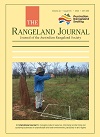Dr Peter O’Reagain
Mr Paul Jones
Dr Nicole Spiegel

The Rangeland Journal
Volume 44 Numbers 5 & 6 2022
Special IssueNRM in the Rangelands – Shaping our Future – ARS Conference Longreach QLD 2021
In October 2021, the Australian Rangeland Society jointly hosted its biennial conference with Desert Channels Queensland in Longreach, Queensland. This Special Issue of The Rangeland Journal showcases papers from the conference.
RJ23017 Abstract | RJ23017 Full Text | RJ23017PDF (855 KB) Open Access Article
 , Susanne Schmidt, Andries Potgieter, Robyn Cowley, Vincent Mellor
, Susanne Schmidt, Andries Potgieter, Robyn Cowley, Vincent Mellor  , Colin Driscoll and Yan Zhao
, Colin Driscoll and Yan Zhao
Monitoring tools for land managers need to be time efficient and easy to use. Monitoring ground cover and biocrusts provides information on soil and pasture health in the savanna landscape. In this research, we showed that digital photos could be used to quantify the post-fire recovery of grasses and biocrusts. This methodology has the potential to be used as an efficient tool for monitoring landscape function in the rangelands.
RJ22019 Abstract | RJ22019 Full Text | RJ22019PDF (5.3 MB) | RJ22019Supplementary Material (405 KB) Open Access Article
In northern Australia, fire management on conservation land usually aims to reduce the negative impacts of large late dry-season wildfires by lighting small patch-like fires in the early dry season. Boodjamulla National Park in Queensland’s Gulf Country previously experienced a large, destructive wildfire approximately every 5 years until a progressive planned burn program broke this cycle. This burn program has had numerous benefits, including improving biodiversity conservation on the national park and pastoral production in the broader community.
RJ22021 Abstract | RJ22021 Full Text | RJ22021PDF (2.2 MB) Open Access Article
Cereus uruguayanus, commonly known as night blooming cereus, is one of many cacti becoming problematic in Australia’s rangelands. Its attractive shape and flowers make it a popular garden plant, but it can escape into surrounding vegetation and establish large infestations. For control in these situations, a novel stem-implantation system used to insert encapsulated herbicides was trialled. Four herbicides achieved high mortality, demonstrating the potential of this technique for control.
Understanding the unseen social identity dynamics of rural communities can provide insights to community leaders, development practitioners and extension officers struggling to innovate and serve rangelands communities. Established socially dominant residents can act collectively against newcomer and outsider efforts to introduce change, solve problems and revitalise communities. Social identity offers a psychological explanation for antisocial behaviours and resistance to new proposals or business or transfer knowledge to rural community.
Long-term paddock surveys from 2003 to 2022 in far south-western NSW showed that best land management practices increased from 14% to 75% of sites. This management change reduced wind erosion from 23% to 9% of sites. Future extension activities targeted at grazing management of stubbles and pastures are required to minimise erosion further.
The available evidence shows that the northern Australian beef industry cannot currently demonstrate whether it is financially and environmentally sustainable. We contend that this will not change if the industry continues to cling to generic industry frameworks with weak criteria. In this paper, we present measurable criteria for sustainability and provide a protocol for the beef industry to improve the trajectory of sustainability in the grazed landscapes of northern Australia.
Rangeland stakeholders including land managers, financiers and regulators require timely and reliable data on how grazing management practices affect the landscape at a range of scales. We developed and tested ground cover maintenance (GCM) maps intended to benchmark annual maintenance of total ground cover over a large part of Queensland, Australia. We conclude that the GCM layers require further refinement, but have potential to meet a number of important needs if identified current limitations can be addressed.
RJ22041 Abstract | RJ22041 Full Text | RJ22041PDF (4.8 MB) Open Access Article
The number of dust storm days has declined by 22% between 1944/45 and 2019/20. Community attitudes, government policy and land management practices have changed over the past 80 years from ‘taming the land’ to ‘sustainably using it’. The result is a higher ground cover and lower wind erosion.
RJ22059 Abstract | RJ22059 Full Text | RJ22059PDF (2.2 MB) Open Access Article